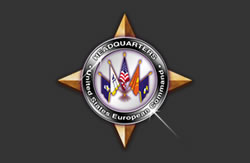U.S., British service members honor French village for D-Day support
Related Topics (6)
More related topics
PICAUVILLE, France (AFNS) -- Air Force reservists and other U.S. and allied military members paid their respects to the people of this small French village June 1 as part of a number of ceremonies recognizing the 68th anniversary of the Normandy D-Day invasion.
Airmen from the Air Force Reserve Command's 302nd, 910th and 440th Airlift Wings, led by Maj. Gen. Wallace Farris Jr., as well as members of the Army's 173rd Airborne Brigade Combat Team and British paratroopers, marched through the village where they laid a wreath in remembrance of those Airmen and Soldiers who paid the ultimate price in liberating Europe.
Later, service members joined together with local residents in the village's sports complex to break bread as well as share stories and even crack a few jokes.
"We are dedicated to remembering the sacrifices of the Airmen and U.S. Army Soldiers who liberated us," said Eric Labourdette, the communication manager for Picauville Remembers, a group that volunteers to maintain the heritage and remembrance of the community's D-Day ties, specifically their assistance to allied service members whose aircraft crashed in the area. "We help ensure the Troop Carrier Monument here in Picauville stands as a remembrance to those U.S. military who gave their lives for France."
After music, food and even a little wine, Farris and other Air Force reservists presented Picauville Mayor Philippe Christine with a custom "shadow box" -- a collection of Air Force mementos unique to each of the wings represented. Christine said it's important to continue hosting events like this "because the story is important."
"The fact that men died here for our liberty ... it's the most important thing for us to keep the memory (alive) and to say to our children what are the facts with history and what importance the landing of (the) U.S. Army (had) to give us our liberty," the mayor said.
The mayor highlighted the unique relationship the U.S. shares with France, going back to the American Revolution and France's commitment to the new nation. He said the U.S.' liberation of France only cemented the nations unique ties.
Earlier in the day, active duty Airmen from Ramstein Air Base, Germany, took part in a remembrance ceremony in Picauville's town square. The gathering brought out more than 200 local residents, World War II re-enactors and children from a nearby school who lit one candle each for those men who gave their lives for freedom after being brought down in the Picauville area.
Maintaining the unique relationship the Air Force Reserve has with this town of 2,008 people, thousands of miles away, helps keep the fighting spirit of D-Day alive year after year officials said. Several organizations in the Air Force Reserve that existed in the early 1940s took part in aerial operations against the Nazi war machine, but it was the 440th AW that maintains a direct link to the first American boots that touched French soil.
Late on June 5, 1944, C-47 Skytrain aircraft assigned to the then-440th Troop Carrier Group took off from Exeter, England. On board those transports were 101st Airborne paratroopers heading directly for the hedge groves of Normandy. The unique heritage of the 440th AW to the D-Day ceremonies isn't lost on the Airmen assigned to the wing today, nor on Farris, who commands 22nd Air Force, the organization that oversees wings like the 440th AW.
"It makes you feel good to be an American," said Farris, commenting on the hospitality of Picauville residents. "But it makes me feel good for the men and women who sacrificed their lives to free France. The veterans who were here today, it means a lot to them as well. We're all able to remember those Americans and what they did here 68 years ago."
Farris, who has flown transport aircraft like the C-130 Hercules for more than 11 years, said the thought of flying a C-47 into the conditions pilots did on D-Day is something that hasn't escaped him.
"Think about the C-47 pilots who flew into very arduous conditions: the weather wasn't the best, you have to 'jeek' and 'jive' to get to the target, you had a hard time finding the target, you had to deal with the flak and you're watching your fellow brethren get shot down at the same time," he said. "You think about that and you try to measure yourself up and being able to maintain a track to the drop zone ... I've thought about that a few times."
And for Christine, he said he is confident having events like this will ensure no one in his community, especially those young school children, will forget what transpired on June 6, 1944.
"Even in the ceremony, we have (a) magnificent exhibition, but not spectacular for the cinema, not the story, but for the memory, " he said. "And when you are a child, it's also spectacular."
The anniversary events culminated for the Air Force on June 3 when they dropped more than 350 allied paratroopers from several aircraft, bringing alive once again the heritage of the U.S. Air Force.
Find more articles tagged with:
- World War II
- WWII
- Airman
- D-Day
- United Kingdom
- Normandy
- anniversary
- paratrooper
- History
- France
- memorial
-

Princess unveils WWII memorial at RAF Greenham Common
Her Royal Highness, Princess Anne, The Princess Royal officially dedicated three memorial stones for U.S. Visiting Forces at the Greenham Business Park in Greenham Common, United Kingdom, Sept. 21.Find more articles tagged with:
-

Exercise Jackal Stone 2012 leaders, participants honor fallen SF comrade
Military members and civilians from the U.S. and Croatia honored the late Master Sgt. Ivica Jerak, a member of U.S. Army Special Operations Command, with a small memorial service held in his native town of Debeljak, Croatia, Sept. 22, 2012.Find more articles tagged with:
-

Operation Rhino Serpent 2012: US, German, British medical troops learn from one another during exercise
Operation Rhino Serpent, a multi-national medical field training exercise comprised of more than 550 U.S. Army Europe, German Armed Forces and British Armed Forces active duty Reservists and volunteersFind more articles tagged with:
-
CE12 Airmen celebrate U.S. Air Force’s 65th birthday
Airmen supporting Combined Endeavor 2012 celebrated the U.S. Air Force’s 65th birthday with representatives of approximately 40 nations and multinational organizations during a cake cutting ceremony Sept. 18.Find more articles tagged with:
-
This Week in EUCOM History: September 10-16, 1959
Nikita Khrushchev becomes the first Soviet head of state to visit the United States.Find more articles tagged with:
-

USS Mount Whitney Remembers 9/11
The crew of USS Mount Whitney (LCC 20) and embarked U.S. 6th fleet staff gathered for a remembrance ceremony to honor those whose lives were lost during the terrorist attacks, Sept. 11.Find more articles tagged with:
-

CNE-CNA Fleet Master Chief Meets Ukraine’s First MCPON, Tours Naval Facilities
The fleet master chief (FLTCM) of U.S. Naval Forces Europe-Africa spent two days touring facilities and meeting junior and senior Ukrainian Sailors along with the recently selected first Ukrainian master chief petty officer of the navy (MCPON) in Sevastopol, Ukraine, Sep. 11.Find more articles tagged with:
-

USS Farragut Makes French Connection
The guided-missile destroyer USS Farragut (DDG 99) departed La Rochelle, France, following a four-day visit, Sept. 10.Find more articles tagged with:
-

USS Farragut Departs Germany, Arrives in France
The guided-missile destroyer USS Farragut (DDG 99) arrived in La Rochelle, France, for a port visit, Sept. 7.Find more articles tagged with:
-

USS Mount Whitney Remembers Fallen Hero
The U.S. 6th Fleet flagship, USS Mount Whitney (LCC 20) held a memorial ceremony in honor of U.S. Navy Chaplain Lt. Vincent Capodanno at Piazza di Capodanno, Sept. 4.Find more articles tagged with:













Comments: 0